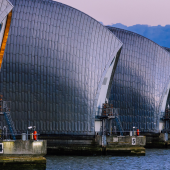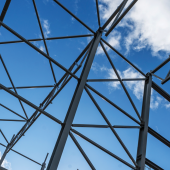A Review of Light Transport Systems in Building
By Christopher Heng Yii Sern
School of Housing, Building, and Planning, Universiti Sains Malaysia (USM), Penang, Malaysia.
Abstract
Daylight has many benefits towards architecture, energy conservation, human psychology and physiology, and visual comfort. Light distribution system (LDS) is one of the means to bring daylight into buildings. LDS is divided into two: light guide system (LGS) and light transport system (LTS). The former redirects daylight up to 10m depth and divided into three types which are vertical, horizontal, and parabolic while the latter can reach more than 10m. This review focuses on the types of LTS and its three main components. The collector is an inlet of LTS that captures incoming daylight and redirects it into the interior. The efficiency of the collector depends on the dimensions, material reflectivity, and the orientation of the system. The daylight will then enter the transporter where every reflection decreases the daylight intensity daylight. There are several types of LTS transporter such as lenses, hollow prismatic pipes, light rods, mirrored light pipes and fibre optics. The shape, size, reflectivity will affect the effectiveness of the LTS. The third component of LTS is the distributor where it distributes the daylight into the interior spaces. The implementation of these components must be considered with the site context such as the climatic condition and orientation.
1. Introduction
Daylight plays an important role in helping to conserve non-renewable resource, increasing the productivity of human through psychological and physiological benefit, and towards building architecture [1,2]. The usage of LDS helps to illuminate the building interior [3]. The system captures daylight around the envelope of the building and transporting it using a reflective mechanism to be distributed into the interior space. LDS is divided into two systems which differs in terms of the illumination depth. LGS redirects daylight to 10m while LTS can reach more than 10m.
2. Light Guide System
LGS functions though guiding the light from its source to the targeted space. The light source that LGS uses are divided into two: direct and indirect sunlight. Louvers, blinds, and holographic optical elements are some examples of system that uses direct sunlight while light shelf, anidolic ceiling, anidolic zenithal opening, and venetian blinds use indirect lighting. LGS can be grouped into three major groups based on the method which the daylight is being guided into the interior. These three groups are vertical, horizontal, and parabolic system. Some examples of vertical LGS are holographic optical elements, laser cut panels, and prismatic panels where it uses reflection and refraction to guide light into the interior. Horizontal LGS uses horizontal elements to reflect daylight. Compound parabolic concentrator where two parabola dishes are placed opposite each other and are coated internally with reflective surfaces sums up a parabolic LGS.
3. Light Transform System
LTS functions to transport sunlight into buildings which has more than 10m depth from the nearest window. These spaces are not exposed or remote from the nearest source of natural lighting. LTS edges ahead of LGS due to several reasons: Ease of lighting cabling and fixtures replacement, economic return with proper system usage, low to none infrared and ultraviolet radiation, reduction of air-conditioning cooling load, and provides safety in hazardous spaces [4]. There are three main components of LTS: light collection, light transportation, and light extraction [2]. The efficiency of these components relies on the light collection capability, solar elevation, and extraction of desired fraction of lighting to create uniform distribution. The deployment of LTS suits climatic condition with rare cloudy condition because of the LTS nature that relies solely on direct sunlight.
3.1 Collector
The collector of LTS is located at the perimeter of a building where it captures incoming sunlight and redirects it into the interior through refracting or reflecting components. Some of the system collimates the incoming light into the transporter to conserve the light intensity. There are two types of light collection systems which are active and passive system [2,5]. Passive collectors are permanently fixed on a surface to capture light. These static collectors are usually big in size as they cannot respond to the movement of the sun. Therefore, the integration of these system must be done during the design stages of a building. This disadvantage is countered by the lower cost of the manufacturing and maintenance. Few examples of passive collectors are laser cut panels [6], anidolic concentrators and a simple dome-shaped collector. The issue of sun movement can be solved by using active collector such as heliostat where it has integrated mechanical components. The collector usually has stored information on the time and sun direction to rotate the opening to gain the most incoming light and could improve the lighting concentration up to 2.5 times comparing to a static system. This information differs from one location to another. The ability of this system to collect maximum daylight in a day must be considered together with the high manufacturing and maintenance cost due to the complicated mechanical component, software, and sensors.
3.2 Transporter
After capturing the light source by using collectors, the light is then being transported into the interior through LTS. The LTS uses three different methods for transporting light: specular reflection, total internal reflection, or converging surface refraction. There are five categories of LTS which are lenses, hollow prismatic pipes, light rods, mirrored light pipes and fibre optics.
Lenses
This system uses a sequence of converging and diverging lenses for transporting light. The converging lens concentrates the incoming light and collimates it along the transporter where another lens will be used to emit it. Accurate calculations are needed to determine the position of the lenses as each lens has different focal point. The absorption and scattering of light of this system and minute movement of the lenses will decrease the efficiency through this optical process and can be worsen by dust accumulation on the surface of the lens [2,5].
Hollow Prismatic Pipes
The concept of hollow prismatic pipes (HPP) is based on a mirrored light pipe and fibre optics. It integrates the low reflective material from the former and total internal reflection concept from the latter. The hollow pipe comprises of small prism-shaped facets on the external wall which is made from transparent acrylic. A HPP functions by reflecting and transmitting the incoming light ray to air space and into the wall material. The latter will be redirected back to the inner pipe and air space through internal reflection with the wall material and facets.
Light Rods
Light rods are a daylight transport system which uses the concept of total internal reflection. Light rods require good optical clarity such as polymethyl methacrylate to maintain the efficiency. The efficiency of the tested light rod, which was 6 times smaller, has similar efficiency with a standard light pipe [7]. These light rods give an alternative to provide daylighting into buildings where large spaces is not available.
Mirrored Light Pipes
Mirrored light pipe (MLP) system comprises of a hollowed mirrored pipe where multiple specular reflections occur at the wall of the pipe. A specular reflection is a mirror-like reflection of an incident ray that has the same angle as the reflected ray. The efficiency of the light transmission depends on three criteria: Incident angle of light, reflectance of the pipe wall and the proportion of length with cross section of the pipe [13]. An efficient MLP can be achieved by tracking the sun, collimating the beam, and enlarging the pipe system which reduces the number of reflections inside the pipe (reducing N in the equation below), and increasing the reflectivity of the reflection layer within the pipe (reaches up to 99%) [8]. However, by doing so, it will increase the production cost (reflection layer and tracking device installation) and reducing the usable or rentable space in a building (enlarging the pipe) [2,8].
Light transmission, T = RN
where, R is reflectance of material and N is number of reflections in LP. T exponentially depends on N and N depends strongly on height and length of LP (cross section of LP’s shape). There are two different type of MLP: vertical MLP and horizontal MLP. Vertical MLP uses light source from the roof opening to be distributed into the interior. Due to the nature of light pipe where less reflectance will increase the efficiency of the system, shorter pipe will perform better than long ones. Vertical MLP has an upright pipe, usually in a cylinder-shaped and a collector in the form of a dome. The advantage of using a vertical MLP is that it receives sunlight throughout the whole day as it is placed on top of the roof [8]. It is contrary to a horizontal MLP where it is placed in a horizontal position such as on top of the ceiling. This causes the limitation in the hours of capturing the sun during the day as the collector is placed along the perimeter which faces only at one direction. The nature of vertical MLP causes it to consume more space which penetrates through the interior area while installation of horizontal MLP sacrifices headroom and increases the overall height of a building.
Fibre Optics
Fibre optics use the principle of total internal reflection where the angle of incidence is larger than critical angle. When the light enters a higher refraction index to a lower one, it will not refract but reflect totally. This makes the efficiency of this system high as the outer cladding (lower refraction index) will prevent leakage of light from the core (higher refractive index). Fibre optic is an effective method to transmit sunlight that can reduce electrical lighting consumption [9]. The efficiency of this system lies on the optical properties such as the line loss, acceptance angle and numerical aperture [2]. It has the advantage of excluding infrared and some ultraviolet radiation from the daylight as the space can be separated from the light source. Besides that, the ability of this system to bend and flex enables it to be utilised in most spaces within a building without the need of forfeiting rentable spaces. Fibre optic has the potential to be integrated with artificial lighting by using the same connections, but the major setback is the technology needed to couple light source to the optical fibre where it requires large collectors to achieve better performance [10].
3.3 Distribution System
The third component of light transport system is the light distribution system. The distributor functions to distribute the captured daylight into the interior of the space. The distribution system may differ from one transport system to another, depending on size and position of the system [8]. A good distribution system will distribute the daylight evenly throughout the room by using certain measures such as a few openings at the transporter or adding a diffuser at the distribution point [11]. There are two types of light distribution system: light extraction and light emission. An ideal case of light extraction is where the daylight is extracted evenly at each aperture. The apertures or avenues where daylight is emitted into the interior spaces vary from a horizontal and vertical pipe system. The former has several openings along the transportation pipe where an equal fraction of light is extracted. On the other hand, light emission functions to distribute and disperse the captured daylight from the transport system. Fibre optics and hollow prismatic guides are some examples of light emitters [12]. Fibre optics emits light through the removal of the outer cladding which is a lower refractive index material. This provides a simple illumination method for a light transportation system. It also can be integrated with Fresnel lens or glass diffuser that produces a wide range of beam width. Besides that, hollow prismatic guide uses the pipe as a mean of illuminating the room with diffuse light and low glare.
4. Conclusion
The implementation of these LGS and LTS on buildings must be considered with the site context such as the climatic condition and orientation. The different systems have certain advantages and disadvantages and must be chosen carefully for the best utilisation of daylight in the building.
5. References
1. Hamedani, Z., et al., Visual discomfort and glare assessment in of ce environments: a review of light- induced physiological and perceptual responses. Building and Environment, 2019. 153:p. 267–280.
2. Wirz-Justice, A., et al., The relevance of daylight for humans. Biochemical Pharmacology, 2020. p. 114304.
3. Hansen, G.V., Innovative daylighting systems for deep-plan commercial buildings. PhD Thesis, School of Design, Queensland University of Technology, 2006.
4. Toledo, G.E., et al., Design parameters for solar light pipes in the Brazilian context. International Journal of Sustainable Engineering, 2016. 9(4):p. 251–258.
5. Heng, C.Y.S., et al., Horizontal light pipe transporter for deep plan high-rise office daylighting in tropical climate. Building and Environment, 2020. 171:106645.
6. Singh, S., et al., A novel method for making laser cut panel based daylight collector coupled to a tubular light guide. Solar Energy, 2021. 218:p. 532–543.
7. Shao, L. and Callow, J.M., Daylighting performance of optical rods. Solar Energy, 2003. 75(6):p. 439- 445.
8. Heng, C.Y.S., et al., Light pipe transporter for high-rise office building in tropical climate. International Journal of Built Environment and Sustainability, 2016. 3(1):p. 36-44.
9. Zazoum, B., et al., Solar optical fiber daylighting system with an IR filter: Experimental and modeling studies. Energy Reports, 2020. 6, 903–908.
10. Mirkovich, D. N., Assessment of beam lighting systems for interior core illumination in multi-story commercial buildings. ASHRAE Transaction, 1993. 99(1):p. 1106-1116.
11. Gil-Martin, L. M., et al., Study of light-pipes for the use of sunlight in road tunnels: From a scale model to real tunnels. Tunnelling and Underground Space Technology, 2014. 41:p. 82-87.
12. Ullah, I., Fiber-based daylighting system using trough collector for uniform illumination. Solar Energy, 2020. 196:p. 484–493.
13. Li, X.,et al., Design and analysis of an active daylight harvesting system for building. Renewable Energy, 2019. 139:p. 670–678.
Author Biography
Christopher Heng Yii Sern is a Senior Lecturer at the Architecture Program, School of Housing Building and Planning Universiti Sains Malaysia. He received his B.Arch and PhD from Universiti Teknologi Malaysia. Dr. Christopher Heng Yii Sern’s expertise involved environmental building simulations and daylighting. His current interests involved architecture, computer modelling and simulations, and green buildings.
This research paper was presented at the 2021 CABE Malaysia Chapter online Conference.









